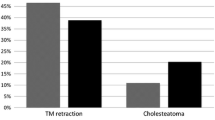Summary
Computed tomography (CT) was used to investigate whether an isthmus block was present in 57 cases with attic retraction cholesteatomas. A ventilation route between the mesotympanum and attic was considered to exist in 30% of the cases and occurred predominantly in those ears with a cholesteatoma that did not extend into the antrum. Four cases were also found to have this ventilation route in CT scans taken before and after the development of cholesteatoma. These findings suggest that an isthmus block is not a prerequisite for the development of an attic retraction cholesteatoma.
Similar content being viewed by others
References
Bezold F (1891) Über das Cholesteatom des Mittelohrs. Z Ohrenheilkd 21:252–263
Chole RA, Tinling SP (1985) Basal lamina breaks in the histogenesis of cholesteatoma. Larnygoscope 95:270–275
Habermann J (1889) Zur Entstehung des Cholesteatoms des Mittelohrs. Arch Ohrenheilkd 27:42–50
Honda Y, Umezawa Y (1983) Pathogenesis of cholesteatoma. Oto-Rhino-Larnygol Tokyo 26:15–26
Morimitsu T, Nagai T, Nagai M, Ide M, Makino K, Tono T, Adachi Y, Kasano F, Fukiyama M, Hayashi A (1989) Pathogenesis of cholesteatoma based on clinical results of anterior tympanotomy. Auris Nasus Larynx (Tokyo) 16 [Suppl 1]: 9–14
Ojala L, Saxen A (1951) Pathogenesis of middle-ear cholesteatoma arising from Shrapnell's membrane (attic cholesteatoma). Acta Otolaryngol (Stockh) [Suppl] 101:33–54
Pfaltz CR (1988) Retraction pocket and development of cholesteatoma in children. Adv Otorhinolaryngol 40:118–123
Ruedi L (1959) Cholesteatoma formation in the middle ear in animal experiments. Acta Otolaryngol (Stockh) 50:233–242
Sadd J, Babiacki A, Pinkus G (1983) The metaplasia and congenital origin of cholesteatoma. Acta Otolaryngol (Stockh) 96:119–129
Shambaugh GE Jr, Glasscock ME III (1980) Pathology and clinical course of inflammatory diseases of the middle ear. In: Shambaugh GE Jr, Glasscock ME III (eds) Surgery of the ear, 3rd edn. Saunders, Philadelphia, pp 186–220
Swartz JD (1986) The middle ear and mastoid. In: Swartz JD (ed) Imaging of the temporal bone. Thieme, New York, pp 33–95
Takahashi H, Hayashi M, Sato H, Honjo I (1987) Chronological changes of pars flaccida in OME after insertion of ventilating tube. In: Sadd J (ed) The eustachian tube. Kugler, Amsterdam, pp 117–122
Tos M (1988) Incidence, etiology and pathogenesis of cholesteatoma in children. Adv Otorhinolaryngol 40:110–117
Tumarkin A (1938) A contribution to the study of middle-ear suppuration with special reference to the pathology and treatment of cholesteatoma. J Laryngol Otol 53:685–710
Tumarkin A (1961) Pre-epidermosis. J Laryngol Otol 75:487–500
Wittmaack K (1933) Wie entsteht ein genuines Cholesteatom? Arch Ohrenheilkd 137:306–332
Author information
Authors and Affiliations
Rights and permissions
About this article
Cite this article
Yamasoba, T., Kikucbi, S. Is an isthmus block a prerequisite for the development of an attic retraction cholesteatoma?. Eur Arch Otorhinolaryngol 250, 300–303 (1993). https://doi.org/10.1007/BF00186231
Received:
Accepted:
Issue Date:
DOI: https://doi.org/10.1007/BF00186231




